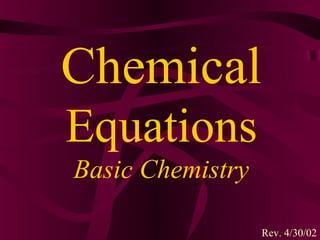
Chpt 9 chemical equations ver2
- 1. Chemical Equations Basic Chemistry Rev. 4/30/02
- 2. Chemical equations show … The reactants and the products Reactants Products
- 3. Chemical equations show … The physical states of the reactants and products: (s) = solid (l) = liquid (g) = gas (aq) = aqueous solution HCl(g) + NH3(g) NH4Cl(s)
- 4. Chemical equations show … • The progress of a reaction … The shows progress from left to right. A double arrow shows an equilibrium between reactants and products.
- 5. Chemical equations show … • The presence of a catalyst A catalyst is a substance that appears not to take part in a reaction, but causes the reaction to go faster. The catalyst is written Pt above the arrow.
- 6. Chemical equations show … • Heat is added to the reaction. Added heat is indicated by the Greek letter delta ( ∆ ) The delta is placed ∆ over the arrow
- 7. Coefficients • The coefficients show the number of molecules or atoms of each reactant and product. • The coefficients are written in front of the symbols • The coefficients allow us to balance the equation.
- 8. Why balance an equation? A balanced equation adheres to the Law of conservation of mass “Matter is neither created, nor destroyed, only changed in form.” We must account for every atom that undergoes a reaction.
- 9. Balancing Equations Example: balance the reaction of hydrogen and oxygen to make water: H2(g) + O2(g) H2O(l)
- 10. Balancing Equations • Make a table under the equation to The equation is kind of indicate the number of each balanced! atom as you change coefficients. 2 H2(g) + O2(g) 2 2O(l) H H 2 4 H 2 4 O 2 2 O 1 2
- 11. We will balance these together: 1. Mn(s) + Cl2(g) MnCl4(S) 2. Al2(SO4)3 Al2O3 + SO3(g) 3. S(s) + O2(g) SO3(g) 4. Na2CrO4(aq) + Fe(NO3)3 Fe2(CrO4)3(s) + NaNO3(aq)
- 12. Balance the Following Equations 1. N2(g) + H2(g) NH3(g) 2. Fe(s) + O2(g) Fe2O3(s) 3. NaHCO3(s) Na2O(s) + H2O(g) + CO2(g) 4. Ba(NO3)2(aq) + Na2SO4(aq) NaNO (aq) + BaSO (s)
- 13. Answers … 1. N2(g) + 3 H2(g) 2 NH3(g) 2. 4 Fe(s) + 3 O2(g) 2 Fe2O3(s) 3. 2 NaHCO3(s) Na2O(s) + H2O(g) + 2 CO2(g) 4. Ba(NO3)2(aq) + Na2SO4(aq) 2 NaNO3(aq) + BaSO4(s)
- 14. “Word Equations” A balanced equation can be written from an expression that describes a chemical reaction in words, rather than symbols.
- 15. To write a balanced equation… 1. Determine the reactants and products. Look for clues: “added”, “produces”, “heated”, “decomposes” 2. Write the correct formulas and put in the state symbols and any other symbols (I.e. catalyst or ∆). 3. Balance the equation.
- 16. Consider the following: Propane gas (C3H8) burns in air to produce carbon dioxide gas and water vapor. Identify the reactants and products. Look for the clue. … to produce …
- 17. If something burns in air, what does it react with? Oxygen What are the reactants? Propane and oxygen What are the products? Carbon dioxide and water
- 18. Write the formulas and symbols: Now balance the equation: C3H8(g) + 5O2(g) CO2(g) + H2O(g) 3 4
- 19. The End